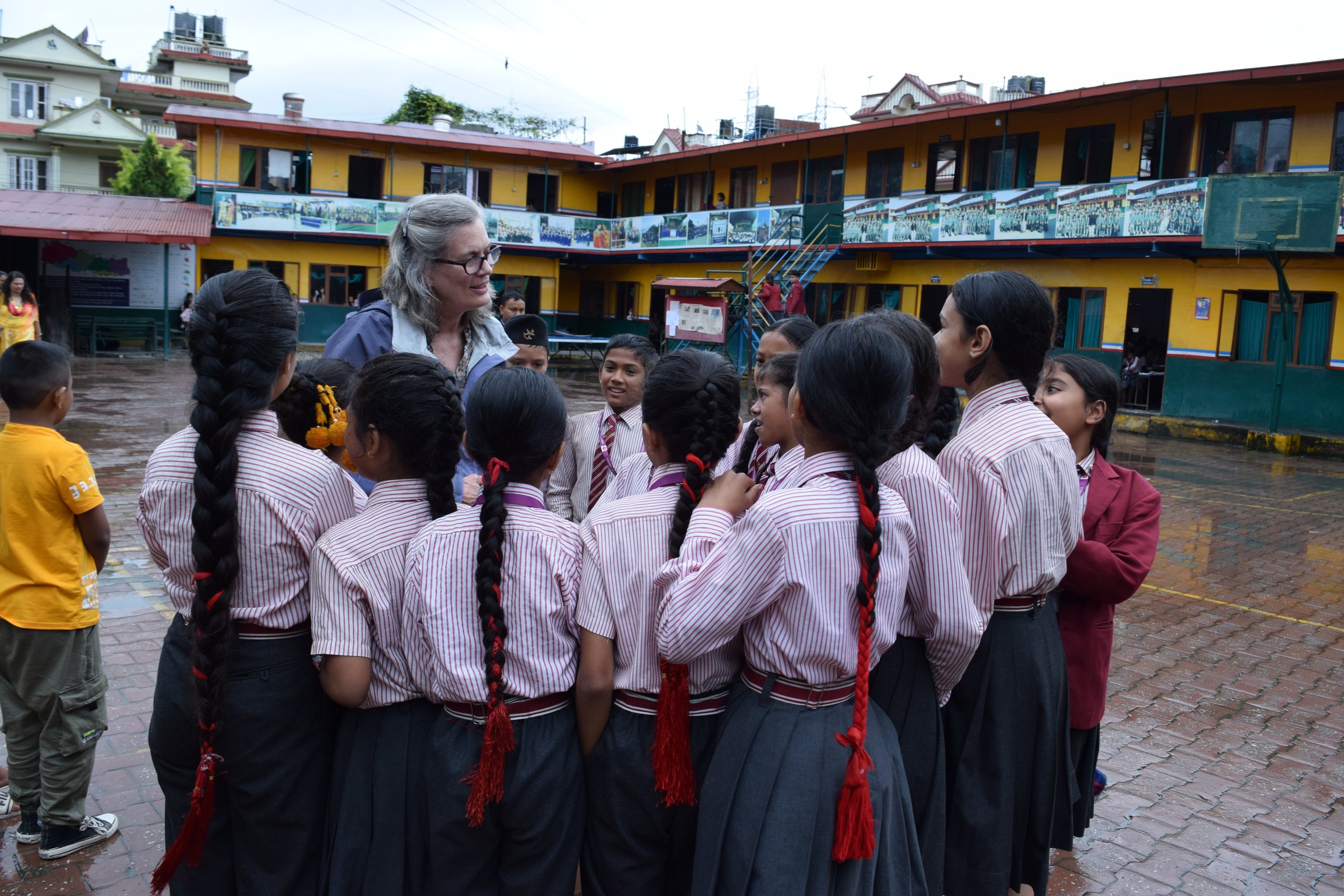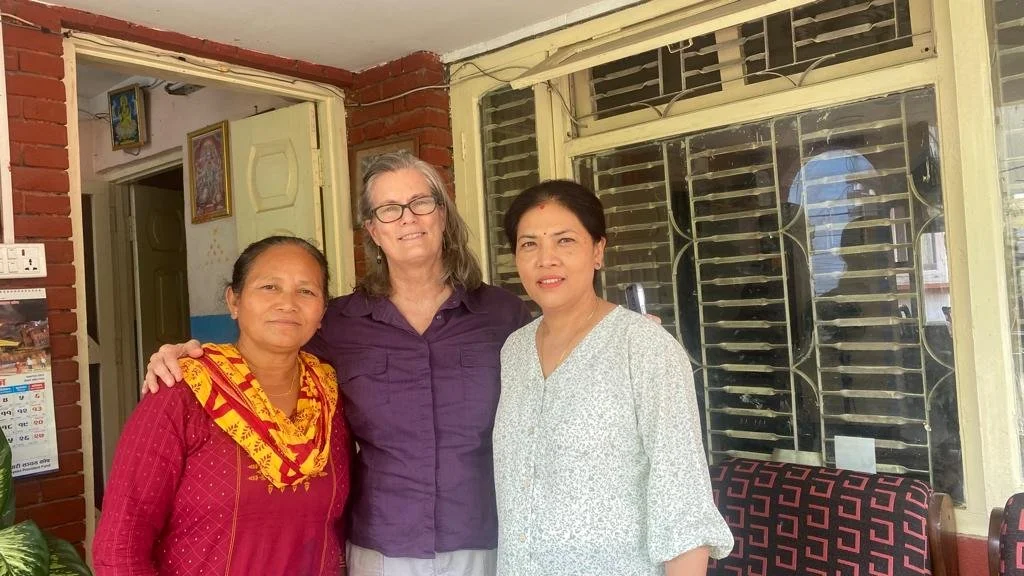CH-CH-CH-CHANGES
Leah Schulte, one of Mitrata’s first advisors reminisces on the many ways Nepal has changed in the 13 years since her last visit:
“I anticipated changes in my beloved Nepal after a 13-yr hiatus. After all, I’ve changed too. And the Nepal ones were evident starting with renovations at Kathmandu’s Tribhuvan Airport and quicker online visa application process. Outside the airport, I was bombarded with huge blinking billboards, taller and densely packed buildings and the common denominator of my 3-week visit; overburdened roads choked with cars and motorcycles. No more wandering cows, push carts or bicycles (a death wish on streets where I once commuted by bike)!
I learned the double wallop of the 2015 earthquake and COVID-19 caused many Nepalese citizens to relocate to Kathmandu. Hence the nasty word “jam” uttered by tourists and locals alike with crosstown transport calculated in hours and fractions. But from the vantage of a tourist bus window during this paralysis, one can study intricately carved doorframes, smartly dressed women on mopeds, ancient temples blessed with red sindur and marvel over the enduring culture of Nepal.
I learned the Nepalese have Pathao and InDrive, like our Uber or Lyft apps, to order a taxi or motorcycle (although typically 1/3 the cost) in Kathmandu which came to my aid a few times. Outside Kathmandu Valley, the pavement was discontinuous, especially post monsoon season which greatly impacted speed of travel. Massive road repairs were visible, like in the past, in this vertically challenged (and blessed) nation! And I was dumbfounded by the scale of a tunnel project underway at Kalanki-Tankot which will greatly improve transportation from the western edge of valley. Another surprise was the plastic or tarp covered greenhouses that dot the landscape where vegetables are grown year-round.
In the hills of Nepal where I irregularly lived and worked for years, the march of progress was evident. Meandering trails were now motorcycle paths, though unpaved and treacherous. Paved roads have been extended. More villages have electricity and improved water systems. Most villagers, even porters and roaming sadhus carry cellphones. “Wi-Fi?” was a common question entering a lodge or shop as the reach and power of internet has grown. In the lower hills I also saw yellow school buses on the roads and school children in smartly dressed uniforms (and thankfully more even boy-girl ratios) as the government is providing more resources to outlying districts and villages to prevent urban migration. In Golphubhanjyang, the one-story stone structure with dirt floors where I once taught was replaced by a multistory building with concrete floors, real glass windows, electricity and even a computer! Villagers also have greater access to government support in agroforestry, via 50% funding for skill training, mini tractors (rototillers), seed, etc. and lower interest loans.
Economically, Nepal remains struggling. Many youths still seek to work abroad. Tourism has not rebounded fully post COVID. My ol’ familiar haunts in Thamel, the tourist center of Kathmandu, were gone. Even the iconic Kathmandu Guest House was unrecognizable with its altered entrance, various wings, a spa, and more. Like elsewhere on our globe, the divisions of wealth were evident. Sadly, I saw many corrugated metal shanties in earthquake-struck villages where the government-allotted 3 lakh (around $2,250 USD) was insufficient for rebuilding their homes. Piles of earthquake rubble remained. But I also saw palatial homes in Kathmandu and Pokhara behind gates, shiny foreign cars (200% additional import tax) and even a brand-spanking new electric charging station for e-cars. While I did see a few Nepalese with credit cards, money transfers on cell phones is common.
The Nepalese spirit remains strong. I arrived to a teachers strike, TV news showing them lying down on the streets of the capital in protest. Later, the nation mourned the 12 citizens killed in erupting Israel-Hamas War and sent planes to collect their remains and the 100+ students studying there. Corruption, ineffectiveness and the recycling of veteran leaders from both the Nepali Congress and revamped Communist Party persist. But a bright spot on the political scene is the vibrant mayor of Kathmandu, Balen Shah, a 33 year old structural engineer, former rapper and an Independent. With an agenda tackling solid waste management (YAY!!), slums, illegal building, valley parking/traffic and more, his following is growing. He’s even caught the international eye (The New York Times May 12, 2023). He appears to instill hope and at least demonstrates a commitment and work ethic not common. Interestingly, while discussing politics with a Mitrata Nepal graduate, he was less optimistic, raising the point that the impact of one strong political leader is limited if the actual foundations of government are weak. While the United States of America was graced with an amazing strong foundation and forefathers that wrote and honored that Constitution, we have little bragging rights now with such division and turmoil. The student’s comments made me think about the trajectories of nations and the impact of leaders vs. institutions. Still, I cheer for Mayor Shah and of course, for Nepal! Plus I feel privileged to witness its transformation, whatever unfolds.
But the highpoint of my journey was reconnecting with Nepalese of my past, especially former OUEST staff Soni Shrestha and Fulmati Thapa who greatly facilitated my trip and whom in OUEST’s early years, helped coordinate with Mitrata activities and students. And sweet Raj, my “child” sponsor after 20+ years, is now a fine young man. Sadly, due to COVID-19, I missed his actual Mitrata graduation party, but he was guest performer this year and sang a lovely song in English. Armed with his Bachelors in Business degree Raj is now working, helping support his mother, playing and teaching madal plus practicing and promoting Sahaja meditation. On my final afternoon, we talked, meditated and picnicked at a park, while capable Raj used a stick to keep the monkeys away! What an asset to the nation!!
During my too brief time in Golphu, I was lucky to meet up with two former village staff who walked an hour or two to see me at an impromptu women’s saving group meeting. We chatted after the meeting while inspecting each other and lying about how none of us had physically changed! We were able to catch up on children grown and gone, the effect of the earthquake and COVID-19, and the reshaping of the village where our lives had intersected. It was sweet and all too short. Before departing I asked one, in my limited Nepali, if he felt his life was better now, 13 yrs later. There was a long pause before he finally quietly said “yes”. I feel blessed to have known the Nepal of the 1990s and to sample the Nepal of 2023. I also hope and pray for the day when I next visit this dear nation that if I ask that question again, there’ll be a definite “YES” without a pause!”
Leah Schulte
Mitrata First Advisor and Child Sponsor






















